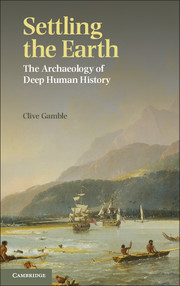Book contents
- Frontmatter
- Dedication
- Contents
- List of boxes
- List of figures
- List of tables
- Acknowledgements
- Glossary
- Web resources for skulls and stone tools
- 1 The worlds of deep human history
- 2 The drivers of climate and environment: Terrae 0–2, 10Ma–50ka
- 3 The recent veneers of climate, environment and population: Terrae 3–5, 50ka to the present day
- 4 Walking and running down the tectonic trail: Terra 0, 10–3.3Ma, and Terra 1, 3.3–1.8Ma
- 5 Three strides across a bio-tidal world: Terra 2, 1.8Ma–50ka
- 6 Going beyond, keeping in touch: Terra 3, 50–4ka
- 7 The call of the north: Terra 3, 50–4ka
- 8 Eyes on the horizon: Terra 4, 4–1ka
- 9 The human reunion in retrospect: Terra 5, after 1400 AD
- Bibliography
- Index
2 - The drivers of climate and environment: Terrae 0–2, 10Ma–50ka
Published online by Cambridge University Press: 05 June 2014
- Frontmatter
- Dedication
- Contents
- List of boxes
- List of figures
- List of tables
- Acknowledgements
- Glossary
- Web resources for skulls and stone tools
- 1 The worlds of deep human history
- 2 The drivers of climate and environment: Terrae 0–2, 10Ma–50ka
- 3 The recent veneers of climate, environment and population: Terrae 3–5, 50ka to the present day
- 4 Walking and running down the tectonic trail: Terra 0, 10–3.3Ma, and Terra 1, 3.3–1.8Ma
- 5 Three strides across a bio-tidal world: Terra 2, 1.8Ma–50ka
- 6 Going beyond, keeping in touch: Terra 3, 50–4ka
- 7 The call of the north: Terra 3, 50–4ka
- 8 Eyes on the horizon: Terra 4, 4–1ka
- 9 The human reunion in retrospect: Terra 5, after 1400 AD
- Bibliography
- Index
Summary
We could not understand because we were too far and could not remember, because we were travelling in the night of first ages, of those ages that are gone, leaving hardly a sign – and no memories… The mind of man is capable of anything – because everything is in it, all the past as well as all the future
Joseph Conrad, Heart of Darkness, 1902Climate and Brains
At the heart of unravelling the complexities of long-term climate change lies a simple concept: climate is cyclical. The concept draws its inspiration from the marked seasons of wet and dry in the tropical monsoon belts and the contrasts between winter and summer in more northerly latitudes. It establishes an agricultural calendar with times of scarcity and plenty and a timetable for planting, harvesting and moving flocks to fresh pastures. What happens from year to year and decade to decade is a matter of weather. These variable conditions never alter the cyclical pattern but do affect the outputs. Weather marks the difference between famine and feast.
This agricultural concept has been applied to the long-term climates of Terrae 1 and 2 where cycles had a frequency of up to 400ka years. A full cycle moves from predominantly cold conditions through to warmer climates; the classic pattern of glacial to interglacial. This stemmed from the demonstration by geologist Louis Agassiz in the middle of the nineteenth century that extensive glaciations once existed in the agricultural heartlands of Europe and North America. Now the date of 1.8Ma sees the first significant glaciations in the Northern hemisphere. It also marks the boundary between Terrae 1 and 2.
- Type
- Chapter
- Information
- Settling the EarthThe Archaeology of Deep Human History, pp. 32 - 74Publisher: Cambridge University PressPrint publication year: 2013



